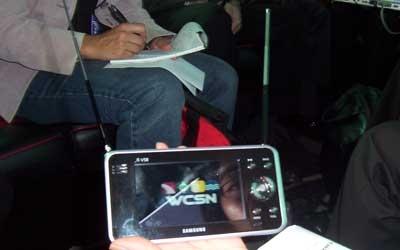A-VSB Takes Digital TV on the Road

| Samsung's A-VSB mobile receiver prototype |
You may not have heard of Advanced-VSB, but it's a new way for a DTV (digital TV) station to divvy up part of its 6-Mhz spectrum for beaming programming to the small screens of mobile devices. This is not high-definition or even standard-definition. With a resolution of 352 x 288 pixels, A-VSB is meant to be viewed on a handheld device or on a small screen mounted in a vehicle. Motion is at 30 frames per second, and the sound is mono.
Samsung, working with the Sinclair Broadcasting station in Las Vegas, arranged for groups of journalists to ride a bus fitted with a pair of 19-inch LCD TVs and a couple of prototype 4-inch portable TVs we passed around. The left screen showed the program currently airing on the station's DTV channel, Maury; the right screen displayed a loop of gymnastics and Ping-Pong matches. During the 25-minute drive near the Las Vegas Convention Center, we occasionally reached speeds of about 45 mph, but we didn't drive through canyons of skyscrapers or underpasses.
The difference between regular DTV and A-VSB reception was dramatic. Except when we were stopped, the picture on the left continually broke into mosaics or froze; the video on the right remained almost always uninterrupted. I did my best to disrupt the picture on a handheld. I shook it. I turned it upside down. Only when I grabbed both antennas was I able to get a sense that I wasn't watching video streaming from internal storage.
Interestingly, it was Sinclair Broadcasting that tried to scuttle the Advanced Television Systems Committee (ATSC) standard as DTV broadcasting began in the U.S. The company favored the European DTV system instead on account of things like ATSC's lack of resiliency for mobile applications. The A-VSB stream consumes as much as 3 Megabits from a DTV station's 19.2-Mbps signal. A disproportionate number of bits are allocated to error correction.
ATSC-supervised field tests are planned for early this year. A completed standard with implementation by broadcasters and product roll-outs by consumer-electronics manufacturers could begin next year. Though the A-VSB channel might be a simulcast of a station's main DTV channel, a Sinclair official said it would more likely be used for dedicated programming, such as real-time video traffic reports.























































